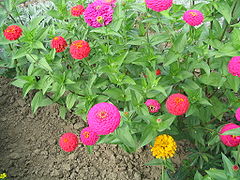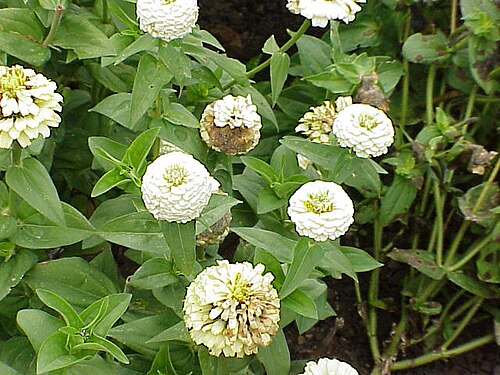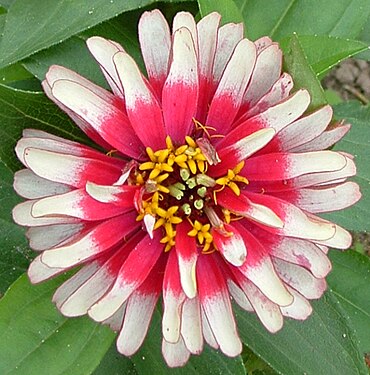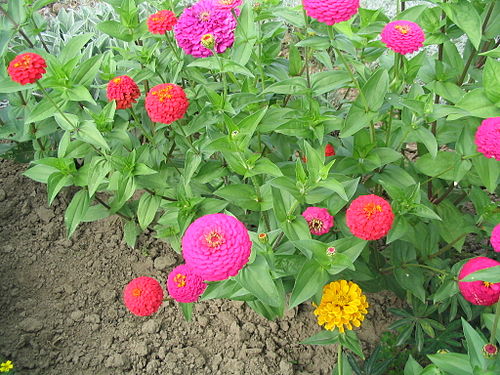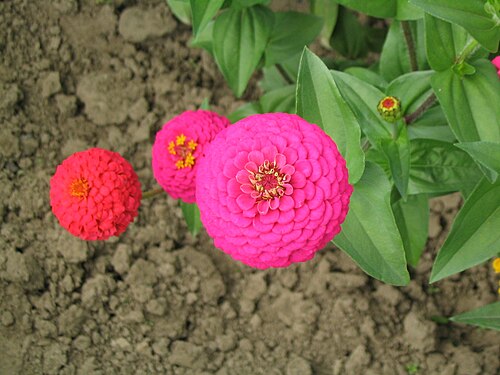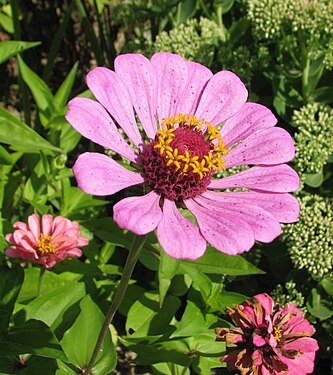Difference between revisions of "Zinnia violacea"
| Line 1: | Line 1: | ||
{{SPlantbox | {{SPlantbox | ||
| − | |Min ht metric= | + | |familia=Asteraceae |
| + | |genus=Zinnia | ||
| + | |species=violacea | ||
| + | |habit=herbaceous | ||
| + | |Min ht box=8 | ||
| + | |Min ht metric=in | ||
| + | |Max ht box=40 | ||
| + | |Max ht metric=in | ||
| + | |Min wd box=8 | ||
| + | |Min wd metric=in | ||
| + | |Max wd box=18 | ||
| + | |Max wd metric=in | ||
| + | |features=flowers | ||
|Temp Metric=°F | |Temp Metric=°F | ||
| − | |image= | + | |min_zone=9 |
| + | |max_zone=11 | ||
| + | |image=Zinnia elegans 02.jpg | ||
|image_width=240 | |image_width=240 | ||
}} | }} | ||
{{Inc| | {{Inc| | ||
| − | Zinnia elegans, Jacq. Youth-and-Old | + | syn. Zinnia elegans, Jacq. Youth-and-Old. Erect annual, a foot or more high, but varying from 3 in. to 3 ft.: lvs. ovate or elliptic, clasping, about 1 in. wide: rays becoming reflexed, originally purple or lilac, but now of nearly every color except blue and green; disk originally yellow or orange, but nearly or quite absent in the common double forms: fls. 2-5 in. across. July to Oct. Mex.—The common species from which most of the garden zinnias are derived. |
}} | }} | ||
| − | |||
| − | |||
| − | |||
| − | |||
| − | |||
| − | |||
| − | |||
| − | |||
| − | |||
| − | |||
| − | |||
| − | |||
| − | |||
| − | |||
| − | |||
| − | |||
| − | |||
| − | |||
| − | |||
| − | |||
| − | |||
| − | |||
| − | |||
| − | |||
| − | |||
| − | |||
| − | |||
| − | |||
| − | |||
Popular garden flowers. Newer cultivars tend to have better disease resistance. | Popular garden flowers. Newer cultivars tend to have better disease resistance. | ||
| Line 44: | Line 29: | ||
==Cultivation== | ==Cultivation== | ||
| − | |||
| − | |||
| − | |||
| − | |||
| − | |||
| − | |||
| − | |||
| − | |||
| − | |||
| − | |||
| − | |||
| − | |||
| − | |||
| − | |||
| − | |||
| − | |||
| − | |||
<!-- Enter cultivation directions here --> | <!-- Enter cultivation directions here --> | ||
| Line 85: | Line 53: | ||
==Gallery== | ==Gallery== | ||
| − | < | + | <gallery> |
| + | Image:Zinnia bed-300px.jpg | ||
| + | Image:Zinnia elegans1.jpg | ||
| + | Image:Zinnia close up.jpg | ||
| + | Image:Zinnia elegans0.jpg | ||
| + | Image:Macroglossum stellatarum.jpg | ||
| + | Image:Zinnia1.jpg | ||
| + | Image:Squaredzinnia2.jpg | ||
| + | Image:Squaredzinnia.jpg | ||
| + | Image:Zinnia elegans 01.jpg | ||
| + | Image:Zinnia elegans 02.jpg | ||
| + | Image:Zinnia elegans 03.jpg | ||
| + | Image:Zinnie-rotgelb.JPG | ||
| + | Image:Zinnia elegans with Bombus 01.JPG | ||
| + | Image:Zinnia elegans 0.03 R .jpg| | ||
| + | Image:Cynia.JPG | ||
| − | |||
| − | |||
| − | |||
| − | |||
</gallery> | </gallery> | ||
==References== | ==References== | ||
| + | *[[Standard Cyclopedia of Horticulture]], by L. H. Bailey, MacMillan Co., 1963 | ||
*Flora: The Gardener's Bible, by Sean Hogan. Global Book Publishing, 2003. ISBN 0881925381 | *Flora: The Gardener's Bible, by Sean Hogan. Global Book Publishing, 2003. ISBN 0881925381 | ||
<!--- xxxxx *American Horticultural Society: A-Z Encyclopedia of Garden Plants, by Christopher Brickell, Judith D. Zuk. 1996. ISBN 0789419432 --> | <!--- xxxxx *American Horticultural Society: A-Z Encyclopedia of Garden Plants, by Christopher Brickell, Judith D. Zuk. 1996. ISBN 0789419432 --> | ||
| Line 101: | Line 81: | ||
*{{wplink}} | *{{wplink}} | ||
| − | + | __NOTOC__ | |
| − | |||
Revision as of 00:21, 9 December 2009
| Habit | herbaceous
| |
|---|---|---|
| Height: | ⇕ | 8 in"in" can not be assigned to a declared number type with value 8. to 40 in"in" can not be assigned to a declared number type with value 40. |
| Width: | ⇔ | 8 in"in" can not be assigned to a declared number type with value 8. to 18 in"in" can not be assigned to a declared number type with value 18. |
| Features: | ✓ | flowers |
|---|---|---|
| USDA Zones: | 9 to 11 |
|
Zinnia > |
violacea > |
Read about Zinnia violacea in the Standard Cyclopedia of Horticulture
|
|---|
|
syn. Zinnia elegans, Jacq. Youth-and-Old. Erect annual, a foot or more high, but varying from 3 in. to 3 ft.: lvs. ovate or elliptic, clasping, about 1 in. wide: rays becoming reflexed, originally purple or lilac, but now of nearly every color except blue and green; disk originally yellow or orange, but nearly or quite absent in the common double forms: fls. 2-5 in. across. July to Oct. Mex.—The common species from which most of the garden zinnias are derived.
|
Popular garden flowers. Newer cultivars tend to have better disease resistance.
- More information about this species can be found on the genus page.
Cultivation
Propagation
Pests and diseases
Cultivars
There are numerous cultivars, including:
- 'Aztek' - white flowers;
- 'Canary Yellow' - 30 in (75 cm), bright yellow;
- Dreamland Series - 12 in (30 cm), double, many colors;
- 'Envy' - 30 in (75 cm), light green fully double;
- 'Giant Purity' - 30 in (75 cm), fully double white flowers;
- 'Halo' - red;
- Mammoth Exhibition Series - 30 in (75 cm), double, large color range;
- Oklahoma Series - 36 in (90 cm) tall, semi-double and fully double, large number of colors;
- 'Polar Bear' - 30 in (75 cm), pure white, double;
- Profusion Series - 12 in (30 cm), single flowers, can be red, orange, or white;
- 'Pulcino' - 16 in (40 cm), semi-double and fully double flowers, many colors;
- Ruffles Series - 27 in (70 cm), double flowers in most colors;
- Splendor Series - 24 in (60 cm), fully double, red, pink, orange, or yellow;
- Sun Series - 20 in (50 cm) tall, double, range of bright warm colors.
Gallery
References
- Standard Cyclopedia of Horticulture, by L. H. Bailey, MacMillan Co., 1963
- Flora: The Gardener's Bible, by Sean Hogan. Global Book Publishing, 2003. ISBN 0881925381
External links
- w:Zinnia violacea. Some of the material on this page may be from Wikipedia, under the Creative Commons license.
- Zinnia violacea QR Code (Size 50, 100, 200, 500)
